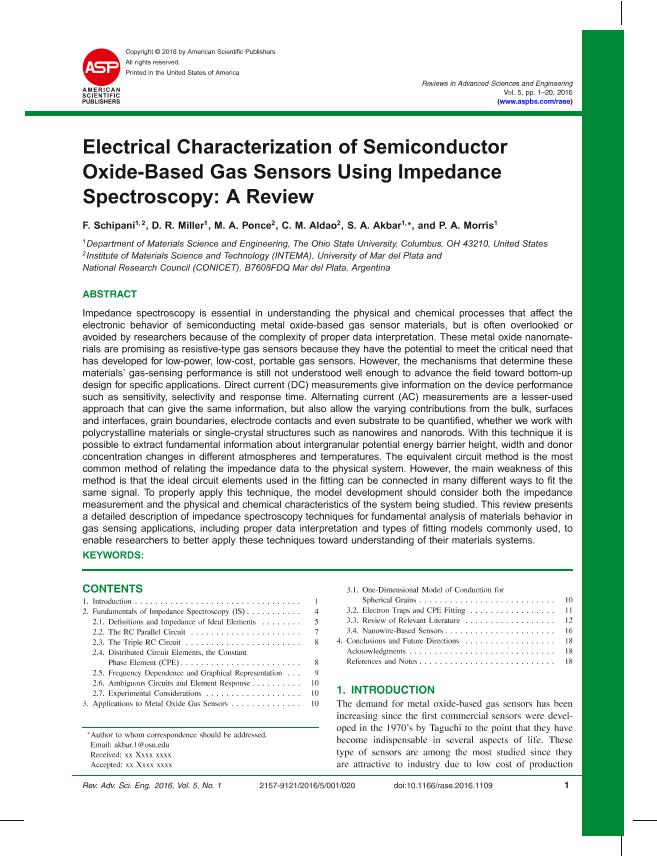Artículo
Electrical characterization of semiconductor oxide-based gas sensors using impedance spectroscopy: A review
Schipani, Federico ; Miller, D. R.; Ponce, Miguel Adolfo
; Miller, D. R.; Ponce, Miguel Adolfo ; Aldao, Celso Manuel
; Aldao, Celso Manuel ; Akbar, S. A.; Morris, P. A.
; Akbar, S. A.; Morris, P. A.
 ; Miller, D. R.; Ponce, Miguel Adolfo
; Miller, D. R.; Ponce, Miguel Adolfo ; Aldao, Celso Manuel
; Aldao, Celso Manuel ; Akbar, S. A.; Morris, P. A.
; Akbar, S. A.; Morris, P. A.
Fecha de publicación:
01/03/2016
Editorial:
American Scientific Publishers
Revista:
Reviews in Advanced Sciences and Engineering
ISSN:
2157-9121
Idioma:
Inglés
Tipo de recurso:
Artículo publicado
Clasificación temática:
Resumen
Impedance spectroscopy is essential in understanding the physical and chemical processes that affect theelectronic behavior of semiconducting metal oxide-based gas sensor materials, but is often overlooked oravoided by researchers because of the complexity of proper data interpretation. These metal oxide nanomaterialsare promising as resistive-type gas sensors because they have the potential to meet the critical need thathas developed for low-power, low-cost, portable gas sensors. However, the mechanisms that determine thesematerials? gas-sensing performance is still not understood well enough to advance the field toward bottom-updesign for specific applications. Direct current (DC) measurements give information on the device performancesuch as sensitivity, selectivity and response time. Alternating current (AC) measurements are a lesser-usedapproach that can give the same information, but also allow the varying contributions from the bulk, surfacesand interfaces, grain boundaries, electrode contacts and even substrate to be quantified, whether we work withpolycrystalline materials or single-crystal structures such as nanowires and nanorods. With this technique it ispossible to extract fundamental information about intergranular potential energy barrier height, width and donorconcentration changes in different atmospheres and temperatures. The equivalent circuit method is the mostcommon method of relating the impedance data to the physical system. However, the main weakness of thismethod is that the ideal circuit elements used in the fitting can be connected in many different ways to fit thesame signal. To properly apply this technique, the model development should consider both the impedancemeasurement and the physical and chemical characteristics of the system being studied. This review presentsa detailed description of impedance spectroscopy techniques for fundamental analysis of materials behavior ingas sensing applications, including proper data interpretation and types of fitting models commonly used, toenable researchers to better apply these techniques toward understanding of their materials systems.
Archivos asociados
Licencia
Identificadores
Colecciones
Articulos(INTEMA)
Articulos de INST.DE INV.EN CIENCIA Y TECNOL.MATERIALES (I)
Articulos de INST.DE INV.EN CIENCIA Y TECNOL.MATERIALES (I)
Citación
Ponce, Miguel Adolfo; Akbar, S. A.; Schipani, Federico; Aldao, Celso Manuel; Morris, P. A.; Miller, D. R.; et al.; Electrical characterization of semiconductor oxide-based gas sensors using impedance spectroscopy: A review; American Scientific Publishers; Reviews in Advanced Sciences and Engineering; 5; 1; 1-3-2016; 86-105
Compartir
Altmétricas



